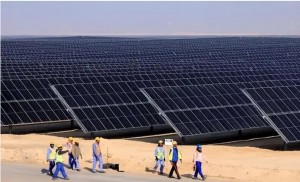In recent years, with the rise of green transformation, photovoltaics have become one of the most popular renewable energy sources worldwide. Egypt, a North African country with rich solar energy resources, has also focused on the field of photovoltaic power generation and continued to promote the rapid development of the photovoltaic industry. In order to promote the development of the local photovoltaic industry, the Egyptian government has continuously improved the management and supervision mechanism, not only setting a grid-connected subsidy price for photovoltaic power generation, but also encouraging strong international companies to participate in Egypt’s renewable energy power market.The in southern Egypt is a typical example of Egypt’s investment promotion and development of the photovoltaic industry with the help of international cooperation.
The Benban Photovoltaic Industrial Park is adjacent to the Aswan Dam, an important water conservancy project in Egypt. With the growth of Egypt’s population and the increase in water consumption, the power generation of the Aswan Dam can no longer meet the local electricity demand. However, Aswan Province has more than 3,000 hours of sunshine throughout the year, providing Egypt with abundant solar energy resources for energy development. In 2019, the Benban Photovoltaic Industrial Park power generation project, one of the world’s largest photovoltaic industrial parks, which was constructed and financed by Chinese companies, achieved full capacity grid-connected power generation, with a total installed capacity of more than 2,000 megawatts. The industrial park covers an area of 37 square kilometers. So far, the installed capacity of photovoltaic projects completed and put into operation is nearly 1.5 GW, making it one of the largest photovoltaic industrial parks in the world.
According to the “2035 Comprehensive Sustainable Energy Strategy” formulated by the Egyptian government, by 2035, Egypt’s installed capacity of renewable energy is expected to reach 61 GW, including 43 GW of solar energy and 18 GW of wind energy. In 2022, 20% of Egypt’s electricity supply came from renewable energy, and this proportion is expected to increase to 42% by 2035. Data shows that when the Benban photovoltaic industrial park is running at full capacity, it can generate 3.8 terawatt hours of electricity per year, which effectively alleviates Egypt’s electricity pressure and promotes the optimization and upgrading of the local energy structure.
Post time: Apr-17-2024
